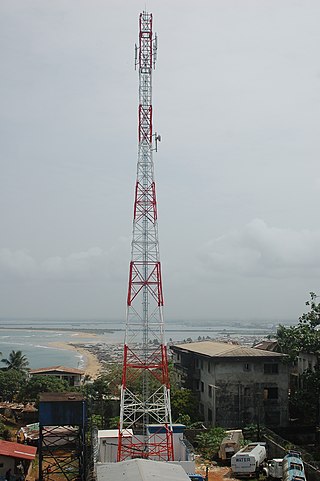Related Research Articles
Telecommunications in Burkina Faso include radio, television, fixed and mobile telephones, and the Internet.
Present-day telecommunications in Canada include telephone, radio, television, and internet usage. In the past, telecommunications included telegraphy available through Canadian Pacific and Canadian National.
Telecommunications in Cameroon include radio, television, fixed and mobile telephones, and the Internet.
Telecommunications in Eritrea are under the authority of the Government of Eritrea.

Telecommunications in Ghana include radio, television, fixed and mobile telephones, and the Internet.

The history of the Internet has its origin in the efforts of scientists and engineers to build and interconnect computer networks. The Internet Protocol Suite, the set of rules used to communicate between networks and devices on the Internet, arose from research and development in the United States and involved international collaboration, particularly with researchers in the United Kingdom and France.

The Internet is the global system of interconnected computer networks that uses the Internet protocol suite (TCP/IP) to communicate between networks and devices. It is a network of networks that consists of private, public, academic, business, and government networks of local to global scope, linked by a broad array of electronic, wireless, and optical networking technologies. The Internet carries a vast range of information resources and services, such as the interlinked hypertext documents and applications of the World Wide Web (WWW), electronic mail, telephony, and file sharing.

Mass media in Liberia include the press, radio, television, fixed and mobile telephones, and the Internet.
Mass media in Libya describes the overall environment for the radio, television, telephone, Internet, and newspaper markets in Libya.
Telecommunications in Paraguay are meager. Paraguay has the lowest fixed-line telephone density in South America, with 5.6 lines per 100 residents, compared with 8.7 per 100 in Bolivia, 21.9 in Brazil, and 24.9 in Argentina.
Telecommunications in Senegal include radio, television, fixed and mobile telephones, and the Internet.
Telecommunications in Trinidad and Tobago include radio, television, fixed and mobile telephones, and the Internet.
Telecommunications in the Bahamas is accomplished through the transmission of information by various types of technologies within The Bahamas, mainly telephones, radio, television, and the Internet.
Telecommunications in the Gambia includes radio, television, fixed and mobile telephones, and the Internet.

The Advanced Research Projects Agency Network (ARPANET) was the first wide-area packet-switched network with distributed control and one of the first computer networks to implement the TCP/IP protocol suite. Both technologies became the technical foundation of the Internet. The ARPANET was established by the Advanced Research Projects Agency of the United States Department of Defense.

NORSAR is a foundation established in 1968 as part of the Norwegian-US agreement for the detection of earthquakes and nuclear explosions. The name derives from the foundation's original project, the Norwegian Seismic Array.
The Internet in Norway is available through Fiber or Mobile. The country code top level domain is .no.

Pål Spilling was a Norwegian Internet pioneer and professor at the University of Oslo and the UNIK Graduate Center at Kjeller in Norway.
The Internet in Botswana is used by approximately 87.2% of the population, as of 2023. There has been a massive increase in internet users since 2013 when only 30% of the population of Botswana was found to use the internet. This is notably higher than the percentage of internet users in Africa as a whole, which is around 43%. For reference, in 2023, the global statistic for internet users is 66%.
Telecommunications in Angola include telephone, radio, television, and the Internet. The government controls all broadcast media with a nationwide reach.
References
- ↑ "CIA World Factbook" . Retrieved 11 March 2018.
- ↑ "Norwegian media barometer 2011 – We watch more television". Statistics Norway. 20 March 2012. Retrieved 13 September 2007.
- ↑ "Percentage of Individuals using the Internet 2000-2012", International Telecommunication Union (Geneva), June 2013
- ↑ "ARPANET Maps 1969 to 1977" . Retrieved 16 May 2012.